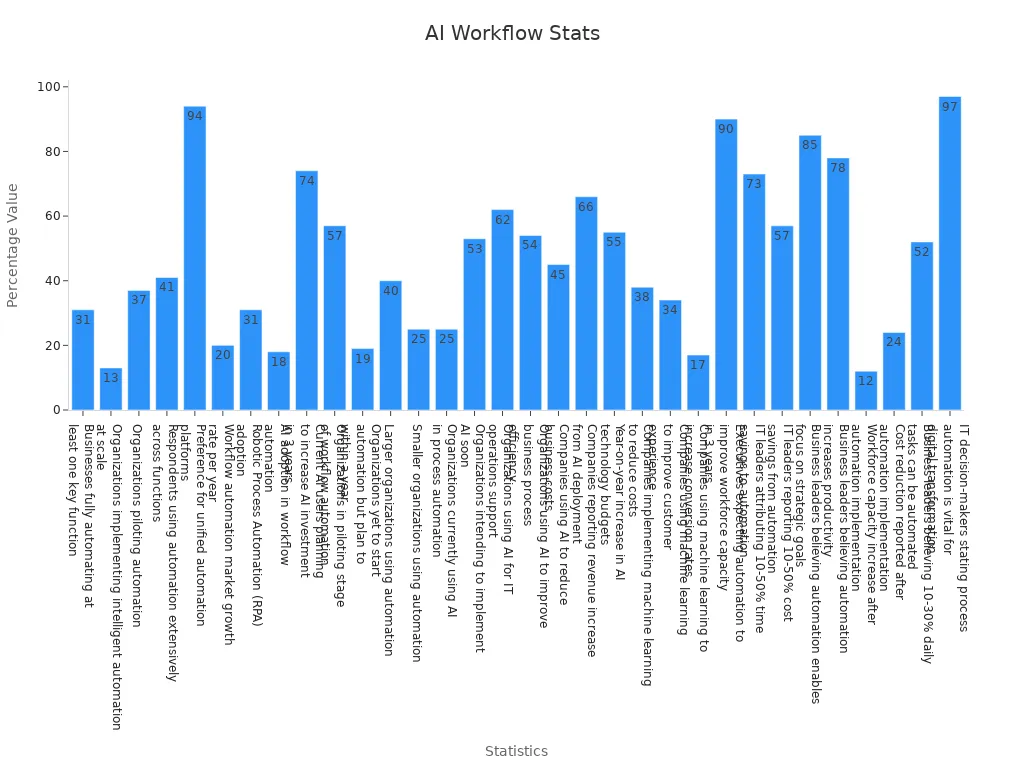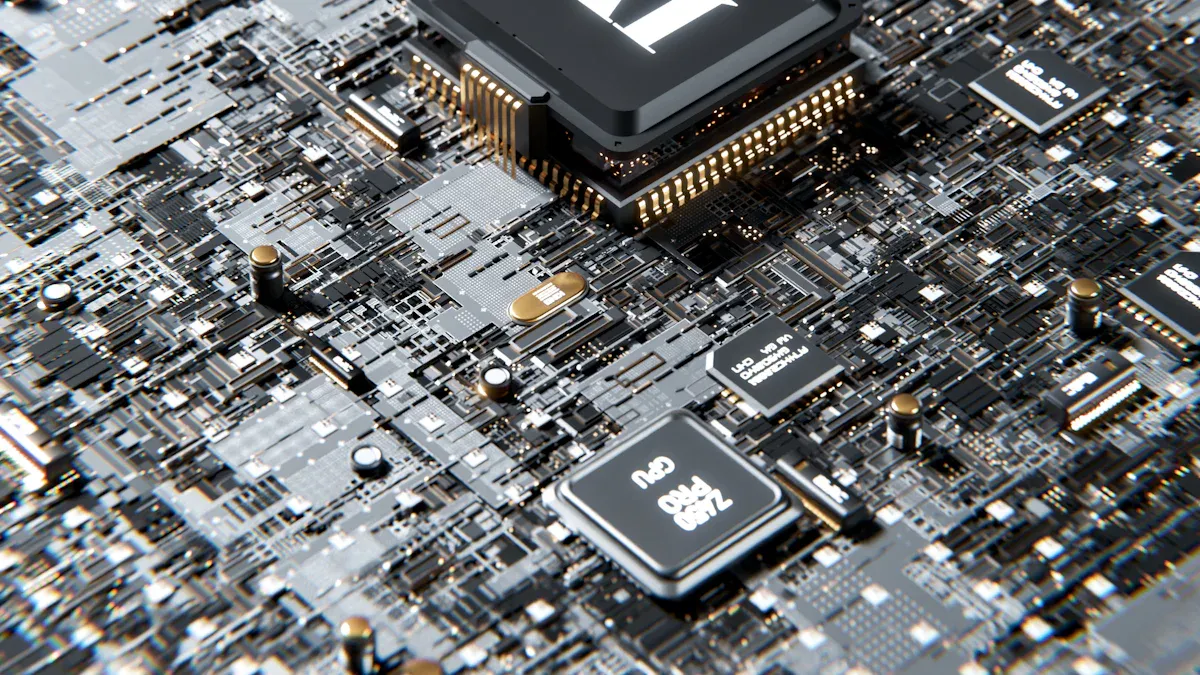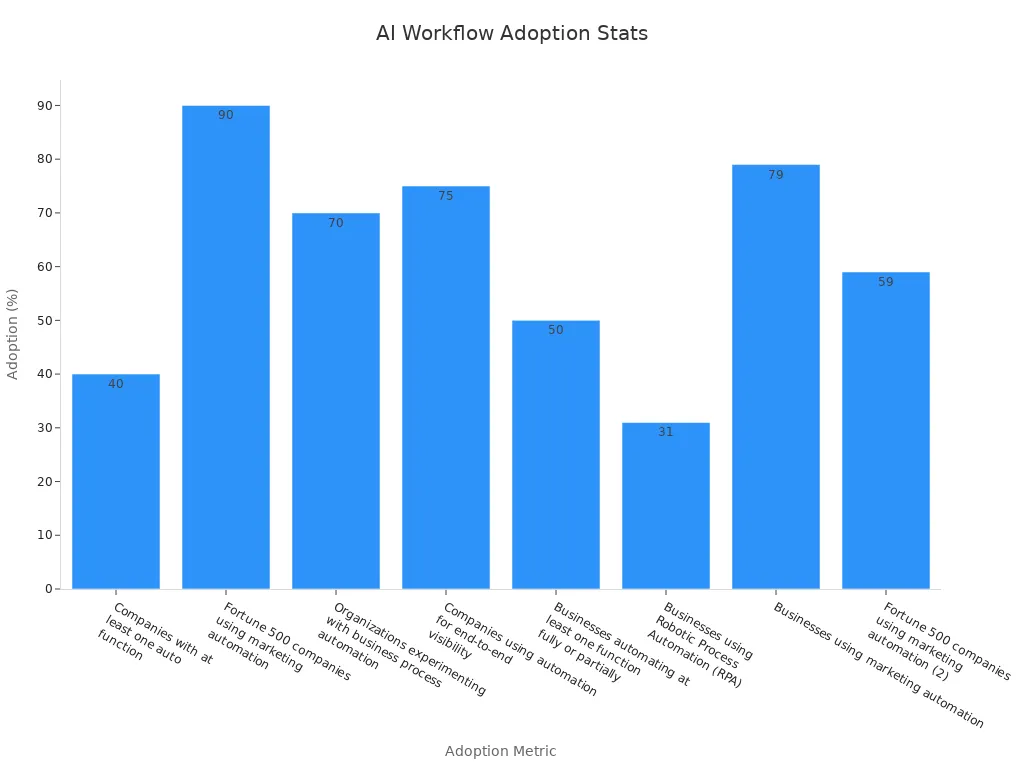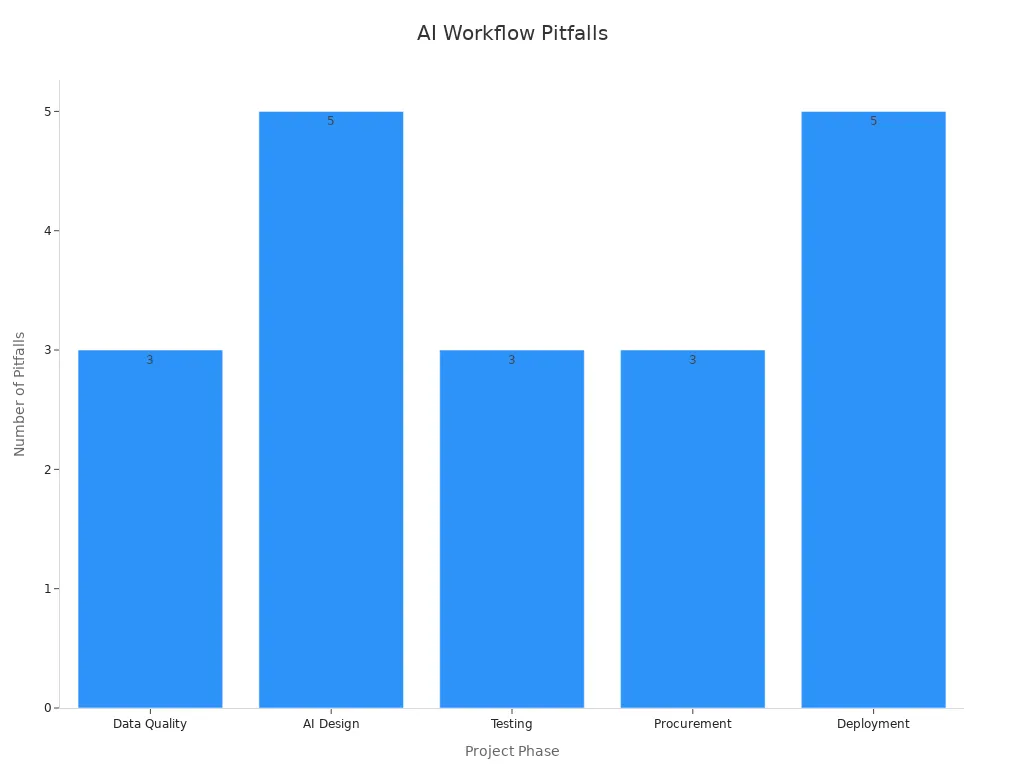How to Use AI to Solve Repetitive Work Challenges

You can now learn how to use AI to automate tedious tasks that were once difficult. Imagine working on a legal team where you spend hours reading witness statements to create event timelines. With AI workflow automation, you simply upload your files, and the system automatically identifies key facts and detects issues. This approach saves you significant time and effort. No-code AI tools make it easy to use AI, even if you don’t have coding skills. More companies are discovering how to use AI every year—about 72% of companies now use AI in at least one area. Additionally, 63% of people report that AI helps their company increase revenue.

Key Takeaways
AI workflow automation helps save time. It does boring jobs like scheduling, data entry, and checking documents. You do not need to know how to code.
No-code AI tools let anyone make workflows. This helps teams finish work faster and make fewer mistakes.
To start, look for daily tasks that happen a lot. Pick the ones that take too much time and give the most help.
Choose AI tools that match your team’s skills and systems. This makes it easier to use and gives better results.
Test your AI workflows well. Watch how they work and keep making them better. This helps you finish more work and helps your business grow.
How to Use AI for Workflow Automation

What Is AI Workflow Automation
AI workflow automation helps you do tasks that have clear steps. Smart algorithms can do boring jobs like sorting emails or entering data. They can also review documents for you. You set up an AI workflow by making a list of steps. The system follows these steps in order. It can read content, find information, and make choices using rules. AI-driven automation lets you finish tasks much faster than before. You do not need to know how to code to use these tools. No-code platforms let you build workflows by dragging and dropping actions. You can make content, handle forms, or set up schedules with just a few clicks.
Many industries now use AI workflow automation. More than 40% of companies have at least one job that is fully automated. Over 90% of Fortune 500 companies use marketing automation. More than 70% of organizations are trying out business process automation. These facts show that AI workflows are changing how people work.

Benefits of AI Workflows
AI workflows give you many good things at work. You can let AI do simple jobs, so you save time and make fewer mistakes. AI lets you spend more time on important work. For example, AI can help with scheduling, payroll, and checking content. This means you get more done and work better.
Tip: AI workflows can save each worker 240-360 hours every year by doing boring tasks for them.
AI-driven automation also makes work more accurate. In healthcare, smart automation cut costs by 42% and made accuracy go from 91% to 99.3%. Many companies say they save 25-50% in certain jobs. You can see these results in the table below:
Benefit Category | Key Statistics & Metrics |
|---|---|
Manager Time Savings | 7-12 hours saved per week on schedule creation, modification, and communication |
Administrative Task Reduction | 50-70% decrease in manual scheduling-related administrative tasks |
Overtime Reduction | 20-30% decrease in overtime expenses through optimized shift distribution |
Employee Satisfaction | 15-30% improvement in satisfaction scores related to scheduling |
ROI | 150-400% ROI within first year; payback period 6-12 months |
AI workflows help you automate, make content, and improve how you work. You can use smart automation to get more done, save money, and make your work more correct. Learning to use AI in your work gives you a big advantage in any job.
Identify Tasks for AI Automation

Spotting Repetitive Work
You can begin using ai by finding tasks you do again and again. Many jobs have steps that repeat every day. These jobs can take a lot of your time and energy. If you let ai handle these tasks, you can do more important work.
Studies say up to 47 percent of U.S. jobs could be automated from 2010 to 2030.
Jobs like data entry, scheduling, and document review are great for ai task automation.
Automation now helps with both simple and hard jobs, like reading medical images or writing news stories.
As ai grows, more jobs can be automated each year.
Look for jobs where you copy information, sort files, or check the same things many times. These jobs can slow you down and cause mistakes. Using ai to automate these jobs can help you make fewer errors and work faster.
Tip: Write down your daily jobs. Mark the ones that feel boring or take too long. These are good choices for ai task automation.
Assessing Automation Potential
After you find jobs to automate, you should pick the ones that help most. Not every job is ready for ai task automation. You should check how much automating will help by looking at key numbers.
Metric Name | Definition | Business Impact |
|---|---|---|
Work finished with automation. | Shows how much more you can do with ai. | |
Managed Service Cost Reduction | Money saved by automating jobs done by people or outside help. | Cuts costs and helps you earn more. |
Deployment Cost Reduction | Time and money saved by automating new service starts. | Gets products out faster. |
Cost per Instance of Process Execution | Cost to run one automated workflow. | Shows how much you save with ai task automation. |
Staff Replacement/Augmentation/Reduction | Change in staff numbers after automation. | Lets you move people to better jobs. |
You can also check what percent of test cases can be automated, how much test automation you have, and how long tests take. These numbers show which jobs will get the most help from ai. When you use ai to automate jobs, your business works better and can grow faster.
Note: Automating jobs does not always mean taking away jobs. You can use ai to help your team do more creative and smart work.
Choosing AI Workflow Tools
Selecting the Right AI Platform
You need to pick the best tools for workflow automation. Many teams use no-code platforms. These let you build workflows without writing code. For legal teams, the AI-Powered Event Timeline Generator by Momen is a top choice. You can upload witness statements or videos. The tool uses ai to find events, make timelines, and spot conflicts. This tool helps you save time and make fewer mistakes in legal work.
Other popular ai tools for workflow automation are Zapier, UiPath, and Microsoft Power Automate. Each platform has special features for workflow management. Zapier is simple for beginners and works with many apps. UiPath is good for big companies with complex automation needs. Microsoft Power Automate connects with Microsoft 365 and helps automate business tasks.
Here is a table that compares some top no-code ai workflow tools:
Feature / Aspect | Zapier | Make | N8N |
|---|---|---|---|
Ease of AI Implementation | Simplest for non-developers; AI Agent builder | Visual, largely no-code approach | Most technical setup; deep customization |
Complexity Handling | Limited for complex workflows | Good for intricate logic | Best for complex logic and custom code |
Data Control & AI Models | Cloud only | Cloud only | Self-hosted; custom/local AI models |
Cost at Scale | Task-based pricing; can be expensive | Operation-based pricing; economical | Self-hosted; cost-effective |
Learning Curve | Lowest | Moderate | Steepest; suited for technical users |
Recommended User Maturity | Beginners, low-code teams | Intermediate, visual builders | Advanced, developer-centric teams |
Tip: Pick ai tools that fit your team’s skills and workflow needs.
Integration Considerations
You should think about how new ai tools will work with your current systems. Many companies have problems when adding ai-powered automation to old systems. You might need to update your IT setup or train your team. Good data management and clear rules help keep your workflow safe and steady.
Many businesses now use ai for workflow automation. ChatGPT is used in over 80% of Fortune 500 workflows. By 2025, 85% of big companies plan to use ai agents. Small businesses are also using more ai each year. You can find ai tools in finance, healthcare, and customer service.
When you plan your automation, look for tools that connect well with what you already use. Good integration helps you get the most out of ai-powered automation.
Implementing AI Workflows
Designing the Workflow
You begin by picking which tasks to automate. Focus on steps that take lots of time or cause mistakes. Many groups do better when they set clear goals and check results before picking AI tools. You should look for problems in your workflow. Find what is hard or slow, then set goals you can measure.
A good workflow design has these steps:
Draw out each step in your process.
Choose which tasks to automate first.
Collect the data needed for AI task automation.
Make rules for how AI will do each task.
Plan how to watch the workflow and check if it works.
Tip: Let your team try out AI tools. This helps everyone learn and makes it easier to use.
No-code platforms let you automate without writing code. Legal teams use the AI-Powered Event Timeline Generator by Momen. It helps with tasks like finding events in witness statements and spotting conflicts. You upload files, and the AI makes a timeline, shows problems, and saves everything in a database you can search. This saves hours and cuts down on mistakes.
Many companies get big rewards from automation. For every $1 spent on AI, businesses get back $3.70, and some get $10 for each $1. Real examples show how AI workflows change industries:
Lexis+ AI saved law firms over 20,000 attorney hours in three years and gave a 344% ROI.
JPMorgan Chase’s COIN platform automated contract review, cutting review time from 360,000 hours to seconds.
Integreon helped a ride-sharing company move data from 3,000 contracts, lowering labor costs by 80% and saving up to 80% of the time.
When you design your workflow, think about how AI will fit with your current systems. Use smart planning to make everything work together. Start with the data you have and make it better over time. If people worry about jobs, show them that AI helps them do more instead of taking their jobs.
A full checklist for AI workflows includes:
Planning goals and ways to measure success
Checking and getting data ready
Trying out pilot programs
Connecting with current systems
Training users
Watching and growing the workflow
Note: People need to watch over AI. Companies like McDonald’s, IBM, and Air Canada show that good oversight helps stop problems like bias and legal trouble.
Testing and Deployment
Testing is very important before you use your AI workflow. You must check if the automation works well and handles real content. Start with a small test. Use a little data and a few tasks to see how the AI does. Check for accuracy, privacy, safety, and if it is easy to use.
Common problems in testing and deployment are bad data, unclear workflow steps, and not enough training. You can avoid these problems by following a plan:
Look for risks early in the AI workflow.
Set goals about risks and ways to measure them.
Use tools and lists to fix risks.
Change your workflow and setup to lower risks.
Check for weak spots with regular reviews.
Phase | Common Pitfalls and Issues |
|---|---|
Data Quality | Bad, missing, noisy, or mixed-up data; odd data points; training or test data that does not match real cases. |
AI Design | Bad or wrong setup; not thinking about the real world; making things too simple; not showing how it works. |
Testing | Not enough real-world tests; not checking accuracy, privacy, safety, or if it works well. |
Procurement | Not checking if AI fits your needs; AI does not match your work. |
Deployment | Bad connections; using weak systems; not teaching users; privacy and safety problems. |
Industry data shows that automation makes testing and deployment better:
Metric / Aspect | Enterprise Implementation | Startup Implementation |
|---|---|---|
Initial Setup Time | 3-5 days | |
ROI Timeline | Good results in 3-4 test cycles | Good results often in first test cycle |
Test Coverage Improvement | About 32% more tests | About 50% more tests |
Regression Testing Time Reduction | 45-60% less time | 60-75% less time |
Bug Detection Improvement | 28% more bugs found before release | 35% more bugs found before release |
AI testing can cover up to 85% more, cut costs by 30%, and make things 25% faster. You also find and fix bugs faster, with up to 90% less wait time.

After testing, you use your workflow for real work. Teach your team how to use the new automation. Watch for problems and ask for feedback. Make changes as needed. If people worry about job changes, show how AI lets them do more important and creative work.
Callout: The best companies work on both change management and technical setup. This balance helps people use AI and get good results for a long time.
By following these steps, you can automate your workflow, make fewer mistakes, and have more time for important work. AI workflows help you automate tasks, manage content, and grow automation in your business.
Optimizing and Scaling AI Automation
Monitoring Performance
You have to check if your automation is working well. First, set simple goals for your ai projects. Use numbers to see if your automated jobs reach these goals. You can look at results for a short time or a long time in different fields. In retail, you might check if sales predictions are right and how much customers spend. In finance, you can see if fraud is caught and if losses go down. In healthcare, you should look at how well diagnoses are made and how patients do after treatment.
Industry | Long-Term KPIs | |
|---|---|---|
Retail | Sales forecast accuracy, Click-through rate | Customer lifetime value, Inventory turnover |
Finance | Fraud detection accuracy, Loan processing time | Reduction in financial losses, ROI of trading |
Customer Service | Chatbot resolution rate, Customer wait time | Customer satisfaction, Cost savings |
Healthcare | Diagnostic accuracy, Patient readmission | Patient outcomes, Healthcare cost reduction |
Manufacturing | Predictive maintenance accuracy, Defect rate | Equipment effectiveness, Downtime reduction |
Let ai help you watch your automation. Predictive maintenance lets you fix things before they break. AI-driven performance tuning gives you ideas to make your jobs better. Automation also helps keep your work safe by looking for problems.
Tip: Check your automation results often. Use what you learn to work faster and better.
Scaling Across Teams
To grow your automation, share your best ai workflows with other groups. Make sure everyone knows how to use the tools. Teach your team to automate their own jobs. Use smart automation to do harder jobs and get more done.
Here are steps to help you scale your automation:
Make simple goals that fit your business.
Use data to find problems and help you decide.
Automate as many jobs as you can to save time.
Watch your ai jobs and change them when needed.
Help your team learn ai skills for the future.
You might have problems like bad data, hard system setups, or people not wanting to use new tools. Keep your data neat and easy to use. Pick automation tools that work with what you already have. Show your team how ai and customer support automation make their jobs easier and help them do more.
Note: Customer support automation and smart automation let you do more jobs and help more people without extra work.
By checking how things work and growing your automation, you make sure your ai keeps getting better. You can automate more jobs, get more done, and help your business grow.
You can change your daily work by letting ai do boring tasks. Begin with small ai projects that matter, like lead management or employee onboarding. These projects usually show quick results, such as faster work and better productivity. Some companies use ai to plan routes and save millions every year. No-code ai tools, like Momen’s Event Timeline Generator, help anyone use automation. This gives you more time for important work. Test new ai tools, check how well they work, and keep making your workflows better.
FAQ
What is a no-code AI tool?
A no-code AI tool lets you build and run AI workflows without writing code. You use a visual interface to set up tasks. This makes AI automation easy for anyone, even if you do not have technical skills.
How do I know which tasks to automate first?
Start by listing your daily tasks. Pick jobs that repeat often and take a lot of time. These tasks usually give you the biggest benefits when you automate them.
Can AI-powered tools work with my current software?
Most AI workflow tools connect with popular business apps. You can use integrations to link your AI tool with email, databases, or document systems. Check if your chosen tool supports your software.
Is my data safe when using AI automation?
Most trusted AI platforms use strong security. You control who can see your data. Always check the privacy settings and review the platform’s security policies before you start.
What results can I expect from AI workflow automation?
You can expect faster work, fewer mistakes, and more time for important projects. Many teams report saving hours each week and seeing better accuracy in their tasks.
See Also
Steps To Develop An AI-Based Needs Assessment Project
Creating An AI Agent For Automating Mobile Repair Scheduling
Effective Methods To Enhance AI Response Precision
